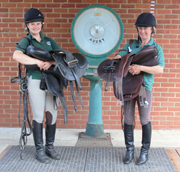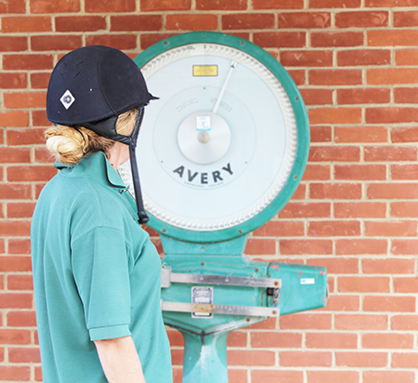Tackling the Issue of a Rider’s Weight in Comparison to a Horse’s Size
First Step Towards Lightening the Load For Horses
September 8-4, 2017 researchers have taken the first step towards tackling the issue of rider weight, investigating whether there are any short term measurable differences when horses are ridden by different sized riders. The aim of the whole project is to develop evidence-based guidelines as to what constitutes excessive rider size under different circumstances, for the equine industry to put into action and prevent needless suffering and injury.
Over recent years there has been considerable controversy about rider weight in relation to horse size. Following the Saddle Research Trust Workshop in 2014 and a meeting of British industry representatives in 2015, an initiative was set up, coordinated by the British Equestrian Federation and World Horse Welfare, to raise funds to support research into this topic.
 As a result, a pilot study has been performed using six horses and four riders. The riders all rode to a reasonable standard, but differed in body weight (light, moderate, heavy and very heavy). Each rider rode each horse, in a randomized order, and performed a standardized 30-minute exercise protocol that consisted mainly of trot and canter. The horses were ridden in their usual tack. Researchers monitored gait subjectively and objectively, behavior, forces under the saddle, alterations in back dimensions in response to exercise, heart and respiratory rates, and salivary cortisol levels. Horses were also assessed the response to palpation of the back. The aim of this stage of the study was to determine whether there were measurable differences in these outcomes among riders of different weights.
As a result, a pilot study has been performed using six horses and four riders. The riders all rode to a reasonable standard, but differed in body weight (light, moderate, heavy and very heavy). Each rider rode each horse, in a randomized order, and performed a standardized 30-minute exercise protocol that consisted mainly of trot and canter. The horses were ridden in their usual tack. Researchers monitored gait subjectively and objectively, behavior, forces under the saddle, alterations in back dimensions in response to exercise, heart and respiratory rates, and salivary cortisol levels. Horses were also assessed the response to palpation of the back. The aim of this stage of the study was to determine whether there were measurable differences in these outcomes among riders of different weights.
All horses finished the study moving as well as when they started. Data analysis is ongoing. However, researchers can confirm that there was a substantial temporary effect of rider weight as a proportion of horse weight (but not necessarily body mass index per se) on gait and behavior. It appears that any adverse influence of less than ideally fitting tack was accentuated markedly by heavier riders. This study does not mean that heavy riders should not ride, but suggests that if they do they should ride a horse of appropriate size and fitness, with a saddle that is correctly fitted for both horse and rider.
The research team owe a huge debt of gratitude to the owners who lent their horses for the study, to the riders, and to World Horse Welfare who provided the facilities for the study.











